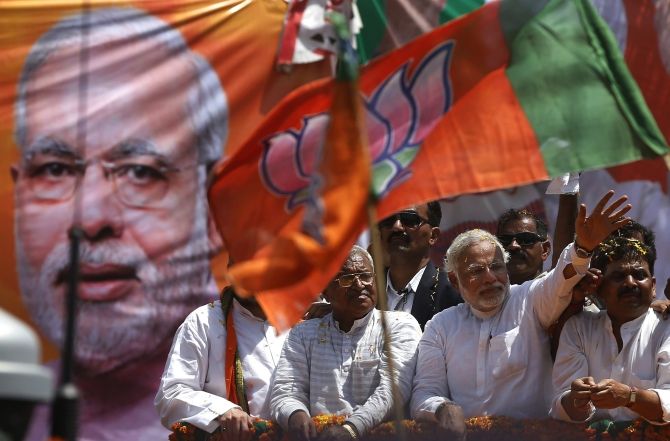
The Uttar Pradesh unit of the Bharatiya Janata Party is buoyant. The Narendra Modi wave has made a significant mark in the state and saffron seems to be the flavour of the month, says Bikash Mohapatra.
The Uttar Pradesh unit of the Bharatiya Janata Party is buoyant. The Narendra Modi wave has made a significant mark in the state and saffron seems to be the flavor of the month.
“We are expecting 35-plus seats from among the constituencies (47) where polling has already taken place,” says BJP state spokesperson Vijay Bahadur Pathak.
“The Narendra Modi factor has clearly had an impact. His various rallies have generated massive public response, and that in turn has tremendously boosted the confidence of the party workers.”
While the party is confident about its fortunes in the first four phases, it is equally upbeat about the two upcoming phases. On May 7, people in 15 constituencies of the state will cast their vote.
And in the final phase on May 12, the remaining 18 constituencies will go to polls that will determine, rather approve, the fate of the party’s prime ministerial candidate (from Varanasi).
“Of the remaining seats we expect to do very well in Purvanchal (18 seats),” says Pathak.
“Some were earlier sceptical about our prospects in the region. But the Modi wave has swung things our way,” he adds.
Besides focusing on his own campaign, Modi has also gone full throttle for his colleagues such as Smriti Irani (up against Rahul Gandhi from Amethi).
While Modi’s victory from Varanasi is a foregone conclusion, it is expected that the Gandhi scion will have to fight it out this time as opposed to the cakewalks he had had earlier.
The United Progressive Alliance’s failure to control inflation will also severely affect its prospects. “The common man holds the Congress responsible for the rise in prices, and as such, doesn’t want them to come back to power,” reasons Kanpur-based journalist Praveen Mohta.
“The Samajwadi Party will achieve its worst-ever performance -- as people are fed up with state government -- while the Bahujan Samaj Party will benefit from the anti-Congress wave,” he adds. Mohta, having travelled throughout the state during these elections, has noticed the change in perceptions from close quarters.
“People from the villages, who previously never voted, have come out to vote for Modi (and the BJP),” he says, adding, “A few people aren’t even aware of the candidates from their constituency but are swayed by the Modi factor and are voting for the kamal (lotus, the BJP’s election symbol).
“You can give any reason for the same, make any analysis, but fact is that the Modi wave is working well for the BJP in Uttar Pradesh.”
The party, meanwhile, is ready for one final assault on the state which will be crucial to its overall fortunes, come May 16. “We are now focusing on each and every constituency left in the fray,” says Pathak.
“Before the elections there were expectations. But after four phases of voting, that has turned into confidence,” he signs off.
Suffice to say if the NaMo factor has had a significant impact anywhere beyond Gujarat, it has to be in the electorally crucial state of Uttar Pradesh.
Image: Narendra Modi campaigns in Varanasi. Photograph: Adnan Abidi/Reuters.










